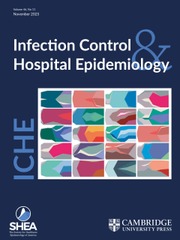No CrossRef data available.
Article contents
A solution for dysfunctional dilution: real-time detection of malfunctioning automated disinfectant dispensers using colorimetric or hydrophobic wipes that indicate disinfectant concentrations
Published online by Cambridge University Press: 24 September 2025
Abstract
Automated dispensers that dilute concentrated disinfectants with water are commonly used but can malfunction. We provide proof-of-principle that incorporating indicators into wipe products could be an effective method to provide environmental services staff with real-time visual indication that disinfectants are present and at correct concentrations with every use.
Information
- Type
- Concise Communication
- Information
- Creative Commons
- This is a work of the US Government and is not subject to copyright protection within the United States. Published by Cambridge University Press on behalf of The Society for Healthcare Epidemiology of America.
- Copyright
- © Department of Veterans Affairs, 2025.
References
Boyce, JM. Modern technologies for improving cleaning and disinfection of environmental surfaces in hospitals. Antimicrob Resist Infect Control 2016;5:10
Google ScholarPubMed
Boyce, JM, Sullivan, L, Booker, A, Baker, J. Quaternary ammonium disinfectant issues encountered in an environmental services department. Infect Control Hosp Epidemiol 2016;37:340–342
10.1017/ice.2015.299CrossRefGoogle Scholar
O’Neill, C, Ramage, L, Wyatt, L, Ballantyne, L. Quality control is indispensable for automated dilution systems with accelerated hydrogen peroxide. Can J Infect Control 2009;24:226–228
Google ScholarPubMed
Cadnum, JL, Kaple, CE, Eckstein, EC, Saade, EA, Ray, AJ, Zabarsky, TF, Guerrero, BJ, Yassin, MH, Donskey, CJ. Dilution dysfunction: evaluation of automated disinfectant dispenser systems in 10 hospitals demonstrates a need for improved monitoring to ensure that correct disinfectant concentrations are delivered. Infect Control Hosp Epidemiol 2024:1–4. doi: 10.1017/ice.2024.148
CrossRefGoogle Scholar
Hawley, B, Casey, M, Cummings, KJ, Edwards, N, Johnson, A, Cox-Ganser, J; National Institute of Occupational Safety and Health. Evaluation of exposure to a new cleaning and disinfection product and symptoms in hospital employees. NIOSH health hazard evaluation report, HHE 2015-0053-3269, 2017. https://stacks.cdc.gov/view/cdc/44556. Accessed May 15, 2025Google Scholar
United States Environmental Protection Agency. OxyCideTM Daily Disinfectant Cleaner. https://www3.epa.gov/pesticides/chem_search/ppls/001677-00237-20191003.pdf. Accessed May 15, 2025Google Scholar
Lake, K, Smith, C, Heinbuch, K, Molinaro, MP. Patent: pH sensitive color indicator for sanitizing applications. Application No. AU 2020274035 B2. 2020.Google Scholar
Sertun™ Rechargeable Sanitizer Indicator Towels with Color Check Technology. https://www.itwprobrands.com/product/sertun-rechargeable-sanitizer-indicator-towels. Accessed May 15, 2025Google Scholar


